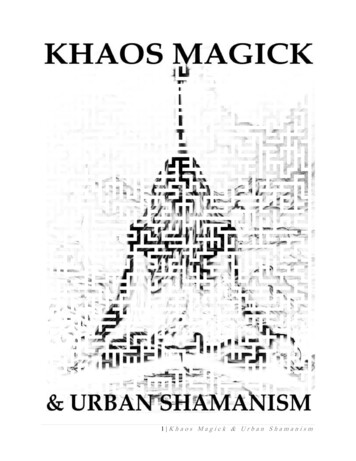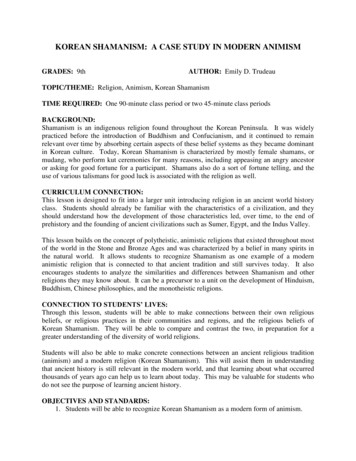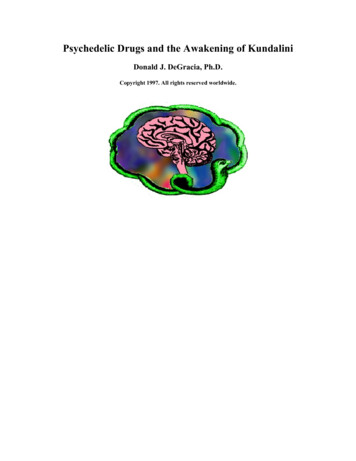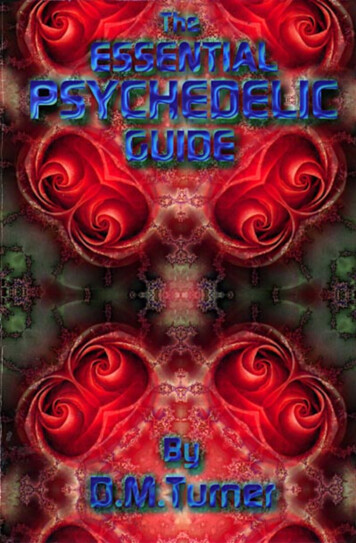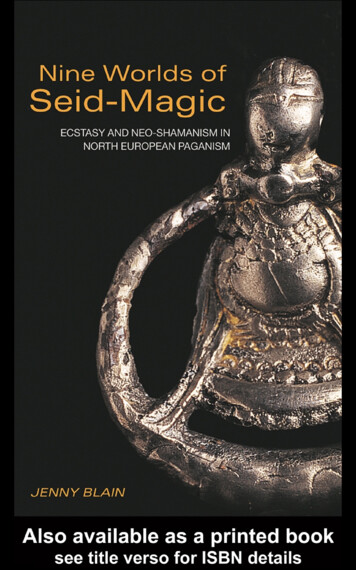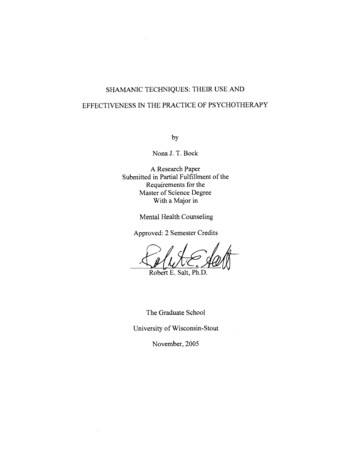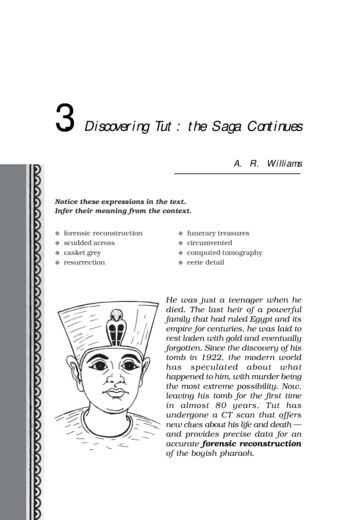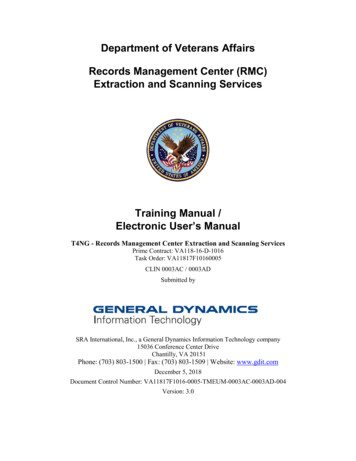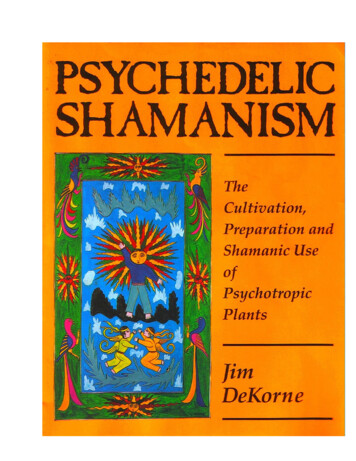
Transcription
Psychedelic Shamanism (Full Edition,Scanned by ReBorn .June.2006)The Cultivation, Preparation and Shamanic Use of Psychotropic Plants 1994 by Jim DeKorneCover photo from a painting by "Pedro D." in the author's private collection.All photos courtesy of Jim DeKorne.Illustrations 1994 by John Megahan/The Technical Sketch.All rights reserved. No part of this book may be reproduced or stored in any formwhatsoever without the prior written consent of the publisher. Reviews may quotebriefpassages without the written consent of the publisher as long as proper credit isgiven. Ooops! me bad!Published by:Loompanics UnlimitedPO Box 1197Port Townsend, WA 98368
CONTENTSAcknowledgmentsforewordPart OneThe Shamanic HypothesisChapter OneAltered StatesChapter TwoShamanic DimensionsChapter ThreeThe Experience of Many WorldsChapter Fourliving In The One WorldChapter FiveThe Entities of The Imaginal Realm — Part 1Chapter SixThe Entities of The Imaginal Realm — Part 2
Part TwoPsychedelic CatalystsChapter SevenThe Belladonna AlkaloidsChapter Eightd-Lysergic Acid Amide:Morning-Glory Seeds, Stipa RobustaChapter NineMescaline: Peyote And San PedroChapter TenAyahuasca and Its Analogues:Harmine And DMTChapter ElevenSmokable DMT from PlantsChapter TwelvePsilocybin:"Magic Mushrooms"Chapter ThirteenThe Minor PsychedelicsChapter FourteenExtraction ProceduresChapter FifteenSome Thoughts About TechniqueAfterwordbibliographyback cover
AcknowledgmentsThis book makes no claim to be definitive; the scope of the subject is obviously toobroad to accommodate any such expectation.The most I can hope for is to pique thereader's interest in exploring the realms of mind-space and sharing his or her findingswith the rest of us.I have done my best to sift through a vast number of sources toselect what seems to me to be true.The mythology surrounding the subject makes thisa difficult task,and I hope all factual errors will be brought to my attention. Some ofthe material herein appeared in a different form in Gnosis Magazine,Spring,1992;Psychedelic Illuminations,Summer,1993;Psychedelic Monographs andEssays,#7,1994,and in both signed and anonymous pieces I wrote for The EntheogenReview, issues 1-5,1992 and 1993. I am deeply grateful to the large number of peoplewho have generously shared their expertise and experience with me while I waswriting this book. For obvious reasons I am not free to acknowledge them byname.They all know who they are anyway. Thanks, friends. I couldn't have done itwithout your help. There's just limited number of bitter substances one person canconsume without getting burned-out!
Finally, it is impossible to write anything on the subject of psychedelics or shamanismthese days without acknowledging the work of Terence McKenna. While I hope thatmy own experience and research may provide some useful new perspectives on thesetopics, it is very difficult not to tread on paths that Mr. McKenna hasn't alreadytraveled, if not blazed himself. Indeed, my interest in these matters was rekindledafter several years of dormancy solely because of my exposure to this man'sbrilliance.
ForewordShamanism goes far beyond a primarily self-concerned transcendence ofordinary reality. It is transcendence for a broader purpose, the helpingof humankind. The enlightenment of shamanism is the ability to lightup what others perceive as darkness, and thereby to see and to journeyon behalf of a humanity that is perilously close to losing its spiritualconnectedness with all its relatives, the plants and animals of this goodEarth. 1We are tearing the earth to pieces, we are spewing out toxins -- andthe entire planet is reacting. Psychedelics are going to play a majorrole in helping people to become aware of what is really happening. 2The draconian laws against psychedelic drugs, including the prohibitionof legitimate research into their effects upon human consciousness areultimately based upon our culture's fear of the new model of realitythat they imply. To put it bluntly, if we took the psychedelic paradigmseriously, we would be forced to change our lives completely. It is hardto imagine anything more revolutionary, and hence (from theconventional point of view), more dangerous and worthy of repression.Drug-induced alterations of consciousness are labeled as deadly,self-indulgent illusions in Western society, hence are seen as achallenge to the status quo and something to forbid for all eternity.The intemperate panic fueling our anti-drug legislation reveals an
appalling irrationality within the national psyche. Murderers routinelyreceive lighter prison sentences than people captured with"unauthorized" plants in their possession!The average sentence served for murder in the U.S. is six and a halfyears, while eight years with no possibility of parole is mandatory forthe possession of 700 marijuana plants. It doesn't matter if the plantsare seedlings or mature -- the federal government treats each as apotential kilo of product. 3Laws like these and the confused and impoverished value system whichallows them to manifest are seriously dissociated from reality. Thepeople who demand them and the people who enforce them have lostall humane perspective, and these appalling statutes long ago forfeitedthe respect and allegiance of rational minds. Injustice always breedscontempt for the law.The irony of this, of course, lies in the distinct promise that psychedelicsubstances offer for the resolution of current human problems at bothpersonal and collective levels. Here are medicines that could help us togrow, yet we make it all but impossible to obtain and use them. That,it seems to me, is a synonym for chronic illness at best, evolutionarysuicide at worst. I am today a psychologically and spiritually enrichedperson because of psychedelic drug-experiences I had decades ago, yetI'd be the last person to proselytize the use of such materials as a pathfor everyone. These substances are powerful catalysts for personalinsight, yet when absorbed into the metabolism of those who are notready for them they have proven to be both individually and sociallydisruptive. Of course this is not a characteristic of the drugs, but of theconsciousness of those who ingest them, and our reactionary lawsagainst psychedelics may be seen as an index of how far we have to goas culture to attain even minimum levels of psychological sophisticationin these matters.Suffice it to say that I and countless other individuals have had deeplymeaningful experiences with hallucinogens which almost certainlywould never have occurred without them. I have learned that humanawareness plays itself out between the of unity and multiplicity, andthat within this multiplicity reside intelligences capable of becomingallies to human endeavor. What is most important it seems to me, is
that such occurrences are not particularly unusual; others have receivedsimilar insights both with and without the use of a chemical catalyst.Mystical writings the world over reveal comparable ideas, and datacollected from researches in depth psychology, comparative religionand shamanism strongly suggest that these perceptions may actuallyconstitute the hidden substructure of consciousness itself! To prohibitlegitimate access to our deepest realms of awareness throughrigid,fear-based legislation may be one of the most egregious errors ofour contemporary culture,nothing less than a denial of our essence ashuman beings.Denial, in the pathological meaning of the word,is an avoidancemechanism deeply embedded within the unconscious psyche; it is anirrational refusal to recognize legitimate challenges to our beliefs andaddictions. Denial, for example, is a common response of alcoholics inavoiding the reality of their condition. Denial is a much larger problemin today's world than just a maladaptive tactic of addictivepersonalities. It is an endemic (and potentially fatal) cultural disease.In her essay, "Denial in the decisive decade," Sandra Postel makes adirect connection between denial as a cultural non-strategy and theworld-wide ecological crisis threatening the stability of our planet:Rather than face the truth, denial's victims choose slow suicide. In asimilar way, by pursuing lifestyles and economic goals that ravage theenvironment, we sacrifice long-term health and well-being forimmediate gratification -- a trade-off that cannot yield a happy ending.There is a practice in the treatment of alcoholism called intervention,in which family members and friends, aided by a counselor, attempt toshake the alcoholic out of denial. A similar kind of "intervention" isneeded to arrest the global disease of environmental degradation.Extraordinary change is possible when enough courageous people graspthe need for it and become willing to act. Once denial is strippedaway, what other option do we have? (Emphasis mine) 4Anyone with the courage to stare reality in the face must acknowledgethat ecological disruptions created by the human exploitation of nature
have grown into autonomous forces, in many cases now beyond the controlof even those sorcerer's apprentices who set them in motion.Natural systems are in an accelerating state of metastasis and the ancientpredator paradigms of Individualism, Nationalism and Exclusiveness havelost most of their relevance. No matter how much we prefer to deny it,such beliefs now have little survival value even for individuals, much lessfor societies.Any plausible solution to these problems implies some recognition ofthe fact that "no part can flourish at the expense of its fellows withoutdoing damage to the whole." Reduced to its essence, this can all besummarized as a crisis in consciousness, a crisis in our collectivecapacity and willingness to perceive ourselves as satellites to a systemof forces transcending the immediately obvious. If our consciousness,the way we perceive reality, is pathologically flawed, then it behoovesthose of us able to realize this fact to find a new paradigm, a new wayto position and perceive ourselves in the flow of time and events.Shamanic cultures have always defined themselves within thattranscendent reality which we have belatedly identified as "expandedconsciousness." Although perceived by us as "primitive," these usuallytribal societies retain a discernment which we have lost to everyone'speril. They do not recognize themselves apart from their surroundingsand often attribute their deepest wisdom to insights provided bypsychedelic catalysts:Nature is not our enemy, to be raped and conquered. Nature is ourselves,to be cherished and explored. Shamanism has always known this, andshamanism has always, in its most authentic expressions, taught that thepath required allies. These allies are the hallucinogenic plants and themysterious teaching entities, luminous and transcendental, that reside inthat nearby dimension of ecstatic beauty and understanding that we havedenied until it is now nearly too late.5If we as a culture are ever going to recant our denial of some of themost elementary facts of life, it seems there is little time left toaccomplish it. If a critical mass of new awareness is to manifest soon
enough to halt the further degeneration of our global life-supportsystems it will have to emerge within the lifetimes of most of thepeople now on the planet. Compared with the time-scale of previousevolutionary changes, this "window of opportunity" is a merenano-second: millions of years of slow mutation concentrated into oneaccelerated moment of choice,the choice of a materially addicted,semi-conscious species to become fully conscious in the instant beforeextinction.Terence McKenna is the primary contemporary advocate for the ideathat the intelligent use of psychedelic drugs among those bestequipped to benefit from them might be one way to achieve suchawareness in the time remaining:The solution to much of modern malaise, including chemicaldependencies and repressed psychoses and neuroses, is direct exposureto the authentic dimensions of risk represented by the experience ofpsychedelic plants. The pro-psychedelic plant position is clearly ananti-drug position. Drug dependencies are the result of habitual,unexamined, and obsessive behavior; these are precisely the tendenciesin our psychological makeup that the psychedelics mitigate. The planthallucinogens dissolve habits and hold motivations up to inspection by awider, less egocentric, and more grounded point of view within theindividual. It is foolish to suggest that there is no risk, but it is equallyuninformed to suggest that the risk is not worthtaking. 6This radical and seemingly eccentric notion has been floating aroundsince the sixties at least. It surfaced in the late '70s in this guise:There is now such a desperate need for humanity to improve itsnavigational skills on the ocean of life that any aid which can hastenthe process should be entertained. Consciousness-altering drugs may bedrastic measures, but what could be more drastic than the problemsnow engulfing the planet? Physicians seldom hesitate to prescribemedicines for sickness of the body. Why then, should we not prescribemedicines for sickness of the soul, especially when our very survival is
at stake? 7The author of this quotation was advocating psychotherapeuticapplications of Ketamine, a legal anesthetic which has profoundhallucinogenic properties in reduced doses. John Lilly, MD, probably theinvestigator with the most experience with this drug, eventually cameto regard Ketamine as too risky for this purpose. It could be arguedthat the primary reason for this reservation was that the research grouphe was involved with apparently lacked a Shamanic structure tomanage the hallucinogenic experience without serious consequences:Several had found themselves prone to "robotlike" behavior carried tothe point where it appeared that the body was actually taken over byalien forces. 8Most people shake their heads at such information, and regard thenotion of "possession by alien forces" as a drug-induced hallucination. Itis this disbelief, based upon the deeply ingrained illusions ofmaterialism, that is the crux of the problem; we are handicappingourselves into extinction by our pseudo-scientific denial of anyperception transcending a narrowly defined consensus reality.Ultimately, we must face the question of how willing we are to acceptthe hypothesis of other dimensions: not the lip service paid to Heavenand Hell by the monotheistic religions, but the possibility of immediatepersonal perception of other realms of experience.One of the major themes of this book concerns the postulate thattranscendent dimensions and the entities inhabiting them are real, andthat much of the challenge of using psychedelics profitably lies inlearning how to integrate such insights into our world-view. The entityphenomenon challenges our will and capacity to take the next step inthe evolution of consciousness at a time when the survival of ourspecies is threatened. Reason suggests that many of the answers to ourspace/time dilemma lie in an analysis of the techniques of shamanismto provide guiding structures for these vital new explorations.
As regards the "legality" of such issues, Noam Chomsky has said: "Thosewho own the country purchase the government." Bob Dylan has said:"You don't need a weatherman to know which way the wind blows." It iseasy to see whose deadly interests are being threatened here, and it isalso easy to see that those powers who profit from destroying the planetare the same powers who will confiscate your property and throw you inprison for the crime of expanding your awareness. When seen in thisperspective, psychedelic shamanism becomes a moral imperative forthose of us who care enough about our lives to live them fully andfearlessly, regardless of consequences. Consequences create newchoices which create new consequences; only a few hundred years agoit was a capital offense to steal a loaf of bread.Having observed all this, it pains me that the litigious nature of ourculture forces me to make the following disclaimer for my own personalprotection: although some of the material in this book may relate totopics which are legally questionable,it is my understanding that whileplants can apparently be declared "illegal," facts of nature and humanideas about them (correct or incorrect) are currently exempt from suchclassification. Everyone has the existential freedom to do what theychoose with what they've read, but that has no connection with what Ihave written in these pages.My responsibility ends where yours begins; readers who act on anyinformation found in this book do so of their own free choice andvolition and must accept all of the consequences of such decisions.We are all on our own in the Shamanic dimensions, and you can thankthe gods for that!Notes1. Harner, M. (1980). The Way of the Shaman, Harper & Row, San Francisco, p.139.2. McKenna, T. (1991). "Sacred plants and mystic realities," The Archaic Revival,Harper, San Francisco, p. 249.3. Potterton, R. (1992) "A criminal system of justice," Playboy, September, p. 47.4. Postel, S. "Denial in the decisive decade," Brown, L. (1992). State of the World,Norton, NY,p. 3, passim.
5. McKenna, T. (1992). Food of the Gods, Bantam,NY, p. 274.6. McKenna, T. (1991). "Plan/Plant/Planet," The Archaic Revival, Harper, SanFrancisco, p. 219.7. Moore, M. (1978). Journeys into the Bright World, Para Research, Rockport,MA, p. 53.8. Ibid., p. 167.
Part OneTHE SHAMANIC HYPOTHESISI haven't changed my mind that [the discovery of LSD] is the mostvaluable discovery that man has made. I think what we've learned inthe intervening years is that this isn't for everybody. It requires muchhonesty -- since self-deception is so easy, but I don't see how anythingcan compare to discovering one's true nature and the magnificence ofthis marvelous universe we are a part of.Stolaroff, M. (No date), quoted by Peter Stafford in Magic Grams: Inquiries intoPsychedelic Consciousness, Rosetta Folios, Berkeley, p. 334.Naive or recreational use of psychedelic drugs does not make one eithera shaman or a saint. If this were true, the [San Francisco] Bay Areawould have been overrun by saints and shamans in 1967. In traditionalShamanic societies, there exist specific traditions, histories, rituals andpractices which provide a stable, long-term set and setting by whichthe drug experiences [are] interpreted and controlled. Gracie and Zarkov(1985) "Psychedelic drugs and shamanism," Notes From Underground, Berkeley,p.1
Chapter OneALTERED STATES[Researchers] have been impressed by the"universality" and samenessof psychoactivedrug experiences across cultures and history.For example, Mandell (1978), after reviewing the experimental andclinical studies of common underlying neurobiochemical pathways in"transcendent states," suggested that "a world view [is] conveyed byusing a brain chemical agent" 1Although this book is about the use of psychoactive plants to accessnon-ordinary states of consciousness, it would be a mistake to attemptsuch a study without first examining some psychological andphilosophical implications emerging from their known effects. TheShamanic cultures using Psychotropic plants have near-universal beliefsystems about them and about the realms of consciousness which theydisclose. This in itself is an amazing fact which suggests importantclues about the structure of the human psyche. Nevertheless, these arerealms seldom seriously examined by Western science -- it's almost as ifthere exists a taboo against considering evidence which, if validated,would completely overturn our concepts of who we are. This book willattempt in part to address this neglect.The following twelve stories were chosen to illustrate some preliminarypsychological data which are considered by mainstream science asanomalous or paranormal at best, as delusions or fraud at worst. They
are all personal, subjective life experiences of my own, and I have toldthem as truthfully as I know how, though the passage of many yearsmay have warped my memory of some Psychedelic Shamanism specificdetails. (For example, I am not certain of the exact year for storynumber eight -- it could have been any time between 1970 and 1973.)The essence of each story, however, is presented exactly as it washard-wired into my memory.1. FIRST LSD TRIPThe Heaven UniverseOn October 25, 1964, from about 3:30 in the afternoon toapproximately midnight, I experienced the effects of LSD for the firsttime. I was twenty- seven years old, a graduate student in English atSan Francisco State College, living in Berkeley with my second wife. Myfriend Dick had obtained the drug from acquaintances associated withthe soon-to-become-notorious author, Ken Kesey. In those days LSD wasstill legal, and a lot was being said about it in both the popular andunderground press. Like many of my generation, I was intensely curiousabout this new substance which supposedly enabled one to experiencea transcendent reality.I swallowed the tiny tab of acid at Dick's family home in Lafayette,then laid back in an old easy chair while he puttered about the house,stopping in every little while to monitor the progress of my trip. Todaywe know that "set and setting" have a lot to do with how oneexperiences any psychedelic drug.That is, the "set" of one's personal expectations and the "setting" orenvironment in which the drug is taken usually determine the qualityand type of experience which will ensue.Although I was then ignorant ofthe set and setting concepts, their accuracy was borne out during thisfirst LSD session.At that time of my life, I was deeply interested in the Eastern religions,and when the drug overpowered my awareness I began to experiencewhat can only be described as samadhi, "the final stage in the practiceof Yoga, in which individuality is given up while merging with the object
of meditation." For the first, and alas, to date the only time in my life,I was "allowed" to experience the unspeakable bliss of total unity andintegration. Subject and object became one -- there were no questionsbecause all that existed was a pristine "answer" in and ofitself,perfectly related to everything else in seamless unity.There wasno good or evil, no right or wrong, only perfection in and of itself.One of the most amazing parts of the experience was how simple andobvious this state of consciousness was; once having experienced such atruth, how could anyone ever see life in any other way? This must bethe way God perceived things.That was how it felt, and it was utter ecstasy.Actually, it was much more than that, but the experience is ineffable,and words cannot capture it.To this day I have wondered how such a state of consciousness can beso close to normal awareness,yet so difficult to attain and maintain.Like any good Berkeley intellectual of that era, I had a pad of paper onwhich I vainly tried (once or twice, before giving it up as absurd) toexpress inlanguage what I was experiencing. I still have that piece of paper.Here is the essence of what is written on it:Koan: "How does one express the inexpressible?"Answer: "Thank you!"If you can follow that kind of "reasoning," you can perhaps get a vagueidea of what was happening with me on that long ago afternoon.LESSON: It is possible to experience a truly objective state ofawareness, to leave subjective, differentiated, ego-awareness behindand dwell in perfect Oneness. Once experienced, this state ofconsciousness becomes the most precious thing one can seek to attain.I personally would give anything to be able to attain it permanently.2. SECOND LSD TRIP -THE HELL MULTIVERSE
On February 21, 1965, I had my second opportunity to experience theamazing effects of LSD. By then I had read Leary, Metzner and Alpert's-book, The Psychedelic Experience -- A Manual Based on the TibetanBook of the Dead. This "manual" was an attempt to structure thepsychedelic experience within the metaphor of those Tibetan scriptureswhich are traditionally read over a recently deceased corpse. Theirintent is to instruct the confused human soul how to navigate the worldof the bardo, the state of existence said to be experienced immediatelyafter the death of the physical body.The analogy of course was that thepsychedelic voyager should allow his ego to "die" by relinquishing allcontrol to a trusted guide, who then selects appropriate verses to readaloud to him as the trip progresses. In theory, the subject will emergefrom the experience "reborn" into a new and permanently higher stateof consciousness, a sort of Instant Enlightenment.In retrospect this seems like an incredibly bizarre concept for a trio ofHarvard psychologists to lay on the unsuspecting American public ofthat time. Remember that, although it had already reached itshalf-way point, the tumultuous decade of the "sixties" had still hardlybegun to define itself, and it was certainly items like a do-it-yourselfLSD therapy manual modeled on an exotic and unfamiliar orientaldoctrine that contributed to the quantum escalation of weirdness in theweeks,months and years soon to follow. It definitely was an instructiveexperience in my case, and I'd be curious to know how many bad acidtrips this one book caused all by itself.Now, I must confess that I didn't use the manual in exactly the mannerprescribed, so that assuredly had a lot to do with the experience whichensued.In the first place, Dick (the only person I knew at that time who hadany experience with LSD) was not available to be my guide; second, mywife was extremely disturbed and threatened by my new-found interestin psychedelics, and very uncomfortable about participating in any wayin my inner voyages. Consequently, not willing to wait until I could usethe technique properly, I made a tape-recording of the manual,reasoning that I would be able to self-select the appropriate verseswhile under the influence of the drug. In retrospect this seems
incredibly naive, not to mention stupid, but as the saying goes: "Itseemed like a good idea at the time."In short, the grossly unfamiliar, electronic-machine sound of my "own"voice speaking such verses from the tape recorder as:"None of the peaceful or wrathful visions,Blood-drinking demons,machines, monsters, or devils,Exist in reality Only within your skull." 2became inexpressibly horrifying. Since the drug had just erased myego, I didn't know who I was at that point and because the demonicimages conjured up by the verses were actually me (didn't "my" voicejust tell me that?) I, strange as it seems now, actually became afraid ofmyself! Not only afraid of myself, but afraid of everything around me--the walls, the floor, the bookcase, my hand, my shoes -- everythingbecame a total threat to "myself," of whom I was also afraid and whobesides that didn't exist anyway -- an appalling enough thought in itsown right! Talk about double and triple binds! I was drifting in aconfused sea of pure terror without any ego-structure to hold onto forreference. Only someone who has had a bad acid trip can understandwhat I'm trying to describe here.In spite of the fact that it terrified me to do so, I went to bed with allof my clothes on, pulled the covers over my head, shut my eyes andassumed a fetal position, shaking in fear all the while. I don't know howlong it was that the diabolical imagery continued, but it seemed likemany hours. Then the sound of a familiar voice drifted in from the frontroom. Another friend had dropped by to visit me, and I bounded out ofbed and grabbed his arm like a child, babbling that I was high on acidand going crazy and that he had to help me or I wasn't going to makeit! Jack would just have to be my ego for a while.Now, Jack was my oldest friend, whom I'd known since high school, anda very solid, very conservative guy who didn't even drink beer. He'dnever had a drug experience of any kind, and naturally had no inklingof what a bum trip was. (Indeed, at this fairly early time in the sixties,the phenomenon was just beginning to surface -- few laypersons knewhow to handle them.) He and I were hot-rod buddies, having misspentmost of our teenage years during the '50s souping up old Fords. While
I'd moved on to other interests, Jack had become a professionalmechanic who still devoted his spare time to building dragster engines.That evening he was on his way to the Oakland Roadster Show, then inprogress, and had dropped by to see if I wanted to come along. He hadno idea of what I was experiencing, and probably felt that it would dome good to get out of the house for a while. Just being in the presenceof Jack's matter-of-fact self-assurance (uncomplicated by anyunderstanding at all of the panic exploding inside my head), made mefeel calmer almost immediately. "Sure, Jack, I'll go to the RoadsterShow with you." My wife, seeing that I was suddenly much better, andwith Jack there to assume responsibility for me, decided to come along.Now that I was "safe," the short drive from Berkeley to Oakland wasone of pure psychedelic rapture. The neon signs and the weaving headand taillights of the cars on the freeway were indescribable works ofenchantment and profundity.Jack was at the wheel and I didn't have toworry about anything. I could have been driven around the East Bay forthe rest of the night in perfect bliss, but the others preferred theRoadster Show.Those readers who can remember the American "Populux" culture of themid-sixties will recall that there was a big "monster theme" ontelevision in those days. The Addams Family and The Munsters weretwo very popular situation comedies, a one-joke genre in which all ofthe humor depended on the "irony" of horror-show monsters living in theAmerican suburbs. Well, the "theme" of the Roadster Show that yearincluded this monster motif, and when Jack and my wife and I enteredthe auditorium, we were greeted with such oddities as "rail-job"dragsters crammed wit
Natural systems are in an accelerating state of metastasis and the ancient predator paradigms of Individualism, Nationalism and Exclusiveness have lost most of their relevance. No matter how much we prefer to deny it, such beliefs now have little surv
